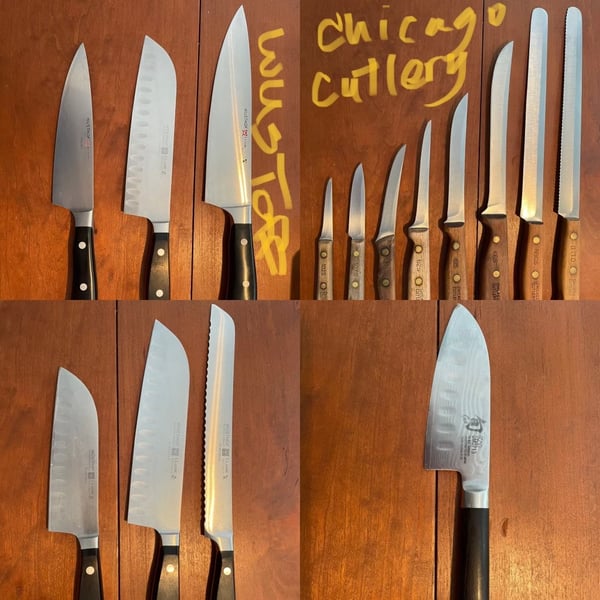This is not a blog on how to purchase knives, determine the ones essential for your kitchen, how to be safe with knives or how to use a knife. I’m not going to speak to how knives are constructed or how to select the best ones for you. Most of that information can be found in our many blogs or probed in our ever-popular Knife Skills class (now being offered virtually).
What I want to do in the simplest way possible, is to break down the main categories of knives (there are not that many) and give you a general idea of what they are used for. When you open up your kitchen drawer or pull out a knife from your knife block, you should be able to look at it and understand what it should be used for.

I often receive texts and emails from friends and family asking me cooking questions, looking for equipment recommendations or recipe ideas. These texts and emails are always welcome; I enjoy sharing what I know… or don’t know. Recently, a dear friend of mine, Tina, inherited a rather large collection of knives from her father. He was quite a collector, and he had a keen eye for knives. He had amassed a rather large collection of them, which are now in Tina’s care. Tina texted me a series of photos of his collection asking me what they should be used for. Her text is what it spurred the idea for this blog. Here are some of the photos Tina sent over.

To understand what knives are used for, let’s start with an understanding of knife techniques themselves. Professional cooking schools throughout the world teach two main knife techniques, slicing and chopping. Most of the knives in your drawer are likely for either slicing or chopping. The reason there are so many different knives in your drawer is so you can size them for the food you are chopping or slicing.
What is the difference between slicing and chopping, you may ask? I certainly suggest you take our Knife Skills class for that is the main thing we teach in the class. Most people who have never had any formal knife skills training use some form of a slicing technique for virtually everything they do. Chefs primarily use a chopping technique. The simplest way to understand the difference is this: when you are using a slicing technique, you tend to lift your knife completely off the chopping block and draw backwards toward yourself when cutting. When you chop something, the knife usually keeps contact with the chopping block and rocks back and forth over the surface of the chopping block, cutting as the knife moves forward.
Here are two videos showing you the difference between chopping and slicing celery:
- Sometimes food can be sliced or chopped. Sometimes I slice celery and sometimes I chop it. It really is a matter of preference.
- You may find that certain food use both slicing and chopping techniques. Chopping an onion or tomatoes are good examples. I would slice the tomato or onion first and then chop the slices to get a dices. I personally choose a Chef’s knife for this job.
Slicing Knives
Slicing knives can be identified by some key features. They are relatively the same width from top to bottom. A pairing knife is a slicing knife - it is used for small jobs and is usually 2 ½ to 3 ½ inches long and is perfect for slicing a mushroom or peeling a garlic clove. A 10-inch-long slicing knife might be used for carving a prime rib roast or slicing a cabbage.
Sometimes slicing knives have a pointed tip and sometimes they don’t. In a paring knife, that sharp tip can come in very handy for removing a blemish out of an apple. A pointed tip on a 10-inch knife may be a little less functional but could still come in handy if you are ever challenged to pierce the thick skin on a whole prosciutto or ham.
Bread knives are also slicing knives, and I think might be the clearest example of the technique of slicing. Visualize slicing bread… yep, that’s slicing! Bread knives are serrated and that serration glides right through difficult to slice foods like bread or cakes. They glide so beautifully that people love to use them for slicing tomatoes, too! There is nothing wrong with slicing a tomato with a serrated knife just know the acid in the tomato dulls the knife quickly and serrated knives are extremely difficult, if not impossible, to sharpen. I would not use your most expensive bread knife to slice tomatoes, unless you don’t mind replacing them frequently.
Chopping Knives
Chopping knives, known as Chef's or French knives, are wide at the base of the knife and narrow at the tip. This graduation in the knife creates an edge that rocks fluidly on the chopping block. Sometimes that graduation is relatively straight and sometimes more curved. These knives also come in different lengths, again this so you can size the knife to the job at hand. A 6-inch Chef’s knife would be perfect for a shallot, an 8-inch for chopping a tomato, but you will need a 10-inch knife to cut that butternut squash in half.
With a Chef’s Knife there are some other considerations, such as efficiency and comfort. The larger the knife, the more you can chop with it and the more efficient you can be. I can chop a whole lot more parsley, a whole lot quicker, with a 10-inch Chef’s knife than I can with an 8-inch Chef’s knife. I find, however, with Chef's knives that it is natural to lean toward a knife that you are most comfortable working with, versus what is most efficient.
The Chef’s knife is really the workhorse of the kitchen and what many chefs use the most. If shopping for a good knife and your budget only allows one really good knife, I would try and steer you toward at least an 8-inch Chef’s knife. Comfort is really important but using a 6-inch Chef’s knife for your main chopping knife is ultimately both inefficient and tiring on the hands and arms. Chefs or very avid cooks who want to be as efficient as possible should consider building their comfort with a 10-inch Chef’s knife.
Butchering Knives
Butchering knives are also narrow at the base and tip but they should not be confused with slicing knives. Butchering knives have curves to the blade, which is also concave in the middle of the blade, and the blade is often flexible. If you never clean a tenderloin, skin a small fish, bone a chicken or clean shrimp you probably don’t need one. If you have something that looks similar to the boning knife but the blade isn’t flexible, it is a butcher knife, they come in all lengths and have lots of subtle variations. Unless you are a hunter or purchase meats in primal cuts these types of knives may not offer a lot of functionality.
Cleavers
Finally, there are cleavers and hatchets. These are commonly used in Asia, but we do see them being used all over the world. Those who love a cleaver generally use this one knife for most everything, much like the European-influenced chefs use a Chef’s knife for most everything. They take that concept to the next degree and use their cleavers for chopping meat and fish with bones still intact, something anyone would value a cleaver for, but they also do intricate work like mincing a shallot or peeling a cucumber. It is magical to watch someone proficient in these skills.
Knifes with No Real Purpose
There are knives that have been designed with no apparent practical purpose. That doesn’t mean they aren’t good or that you won’t like them… just don’t expect an answer when you ask an expert what they are used for. Knife companies occasionally make knives with crazy designs just because they think people will buy them. I’m not going to give you examples, because I do not want to badmouth a crazy knife purchase you may have made… if you love a knife you have and it doesn’t seem to fit into slicing, chopping or butchering categories, don’t worry, just love your knife and use it how you like.
In your drawer or knife block, you likely have 3 main styles of knives: slicing, chopping and butchering knives. The different lengths allow you to size the knife to the food you are working with, it’s just that simple.
Appropriate sized knives for chopping cabbage
Appropriate sized knives for slicing cabbage
You might find a boning knife, a butcher knife or a cleaver in your drawer, and you haven’t used them yet. Perhaps you will in the future, now that you know what they are for. These more specialized knives may not be used as much but are just as valuable when you are called to use them. If you happen to have an oddball knife in your drawer and you like to use it, proudly continue to do so!
Learn how to utilize the knives you have in your kitchen and hone your slicing and chopping skills in a virtual Knife Skills class. Choose from:
- Saturday, February 6 3pm CST
- Wednesday, February 17 6pm CST
- Wednesday, March 3 6pm CST
- Saturday, March 20 11am CST




